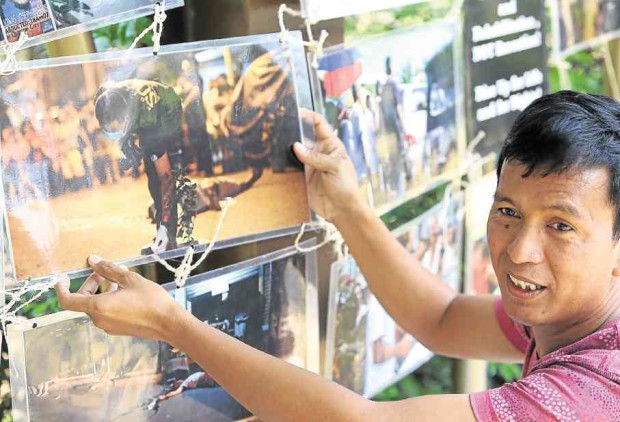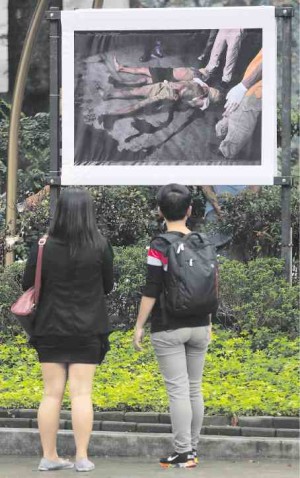Pray, point and shoot: Churchman puts drug war into focus

Through his camera, Bro. Ciriaco “Jun” Santiago documents killings linked to the government’s war on illegal drugs. Some of his photos were put on exhibit at Baclaran church in December last year.—Photos by MARIANNE BERMUDEZ
A religious brother by day, a “ghoul” by night.
That might well describe Ciriaco “Jun” Santiago III who spends his days serving in church and his nights documenting drug-related killings through his camera.
“It’s not just my personal apostolate,” said Santiago, 46, a Redemptorist brother who attends to his duties at the National Shrine of Our Mother of Perpetual Help in Baclaran, Parañaque City, before rushing off to the Manila Police District (MPD) press office before 9 p.m. “When I click my camera, it’s not just me, but all my Redemptorist brothers behind the lens.”
The Paombong, Bulacan, native has been documenting crimes scenes all over Metro Manila for four months now, taking compelling photos of people killed in the government’s antinarcotics campaign known as Oplan Tokhang.
Santiago’s photographs of the bloody war were submitted by the ecumenical group Rise Up for Life and for Rights to the communist-led National Democratic Front of the Philippines before the third round of peace talks between the government and the NDFP in Rome.
Article continues after this advertisementSome of his work have been included in a photo exhibit on extrajudicial killings, while others will be used in a video being produced as part of an awareness drive on human rights.
Article continues after this advertisement“Brother Jun,” as he is known to fellow photographers on the police beat, bought his first Nikon camera for about P70,000 in 2006. He now uses a Canon that a priest had gifted him.
Nightly jaunts
Santiago’s nightly jaunts began on Dec. 1, 2016, after he volunteered, initially for two months, to document the killings linked to the Duterte administration’s antidrug campaign. His first photo was that of a man gunned down in a slum area in Tondo, Manila, that night, just before 10 p.m.
Having worked in disaster management for a nongovernment organization during the 2006 mudslide in Southern Leyte province, Santiago is no stranger to death and corpses. So the grisly sight of the dead man did not disturb him as much as the pained cries of his anguished family.
“At first, no one was crying. But once the policemen left the crime scene, the weeping began. I could not take a photo of them, but could only listen to their story,” he said.
According to the neighbors, several men who introduced themselves as police arrived in the community and saw the victim, known to the residents only as Michael, and asked for his name. He was their target, one officer said, since his name began with “M.”
Despite the man’s protestations of innocence—“I’m just a street sweeper,” he said—the assailants shot him dead and fled.
11 killings
There was more to hear of the chilling narrative, but Santiago and the other photojournalists had to rush to another crime scene.
Santiago photographed 11 killings on his first night.
“I felt it was not a war on drugs, but a war on the poor. Most of the victims lived in slum areas, with houses made of tarpaulin,” he said, adding that his heart goes out to the families left behind, especially the young children who could not understand why their father was mercilessly killed.
Santiago noted that the number of killings seemed to have declined—from an average of 13 a night in December, to 11 in January and 9 in February. Most of the killings happened in the northern cities of Caloocan, Malabon and Navotas.
Before going off on the night shift that starts at 7 p.m., Santiago joins his fellow Redemptorist brothers in a community prayer at Baclaran church. A quick dinner follows before he rushes off to the MPD press office.
“I have to be at the MPD before 9 p.m.,” he said, adding that he constantly murmurs a prayer asking the Holy Spirit to guide him in his work.
Whenever there was a lull in the killings, he and the other lensmen would visit the wakes of the victims they had earlier photographed.
At the end his shift around 3:30 a.m. the following day, he heads back to Baclaran church to get some sleep—and must be up again by 9:30 a.m. for Mass.
On mornings and weekends, Santiago attends to his church duties as a finance officer and also manages the upkeep of the church surroundings.
Santiago recalled only two nights when they had no deaths to cover: on Feb. 1, shortly after President Duterte called for a halt on the war against illegal drugs, and one night in December when the police had their Christmas party.
Grisly, traumatic
One memory on the beat that he could not shake off was the funeral of three teens killed during a street party in Caloocan City in December and buried side by side in a single grave at Tala Cemetery.
“I cannot forget the sight of them buried together, their coffins side by side. It was cheaper and their families had little money,” Santiago recalled.
Despite the weight of those traumatic images on his memory, Santiago considers himself fortunate for being able to share his experiences and thoughts with his other Redemptorist brothers.
“They give me their full support and listen to my experiences during recollection. I am also able to express (my thoughts) through prayer. It’s not just about me but about the Redemptorist community.
“I have my brothers with me, and my relationship with the Lord has deepened over time,” he added.
Aside from Santiago’s documentation mission, Baclaran church also provides counseling, funeral assistance, legal aid, livelihood support and sanctuary to families of Tokhang victims.
The documentation mission was supposed to end in January, but with the government relaunching Oplan Tokhang, the Redemptorist brother took up his camera again.
The effort might look small in the grand scale of things, but Santiago sees no reason to stop his work of documenting the drug war’s nameless dead. “In five to 10 years, we might go back to these photographs,” he said. “There is no need for me to stop because it’s a community apostolate. This is not just a job, but a church mission.”
